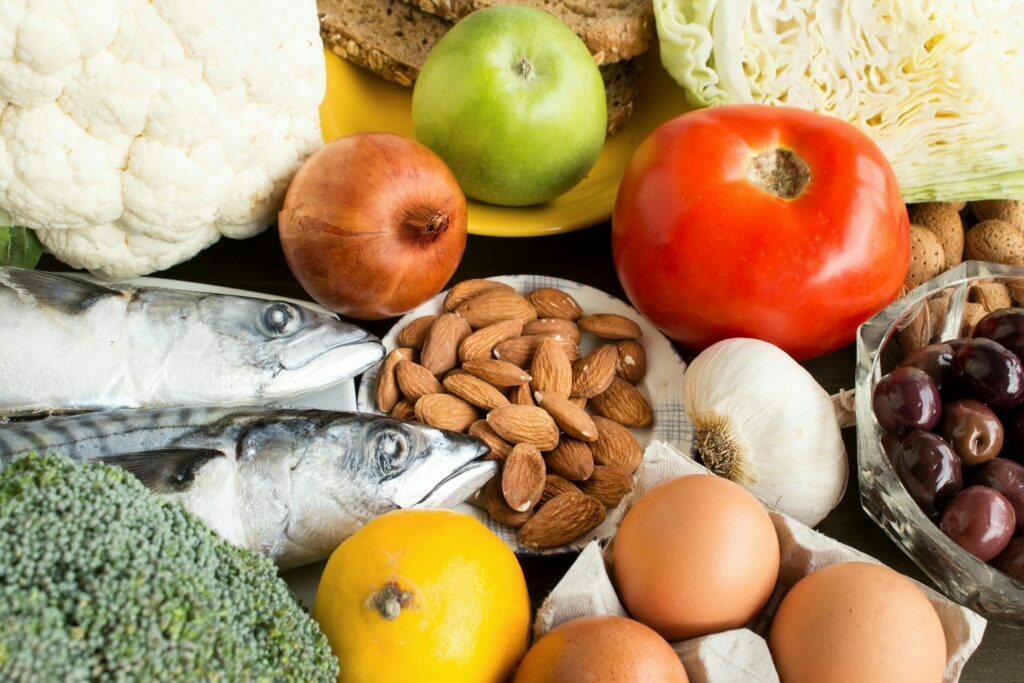The World Health Organization (WHO) stated that by the year 2030 diabetes would turn out to be the world’s seventh-largest killer.[1] Diabetes is a chronic, metabolic disease characterized by elevated levels of blood sugar or blood glucose therefore it needs dedicated medical care and attention. Diabetes doesn’t mean that you cannot eat your favorite foods, but you do need to monitor your blood glucose levels to stay safe and on track. By incorporating these 10 foods into your daily diet, you will not just give your body the nourishment it needs but the health outcomes you need to achieve. That is why choosing the best foods for people living with diabetes is crucial and carefully selected. Here are the top 10 best foods for people living with diabetes.
1. Fatty Fish
Scientists and researchers have revealed that the consumption of fish may reduce the risk of developing type 2 diabetes.[2] Fish is a suitable and good food for people with diabetes. It is a great source of high-quality protein, which helps you feel full and helps stabilize blood sugar levels. Protein in fish satisfy some of our energy needs and omega 3 fatty acid may help our heart health. Low levels of vitamin D are common in people with diabetes, so fish in the diet is a good way to add to your dietary vitamin D intake.
People who eat fatty fish regularly have a lower risk of acute coronary syndromes, like heart attacks, and are less likely to die from heart disease. Getting enough of these fats on a regular basis is especially important for people with diabetes, who have an increased risk of heart disease and stroke. Eating fatty fish may also help regulate blood sugar. Salmon, sardines, herring, anchovies, and mackerel are great sources of the omega-3 fatty acids DHA and EPA.
2. Avocados
Avocado is an ideal snack for people with diabetes. Avocado consumption is connected with improved overall diet quality, nutrient intake, and reduced risk of metabolic syndrome. It contains monounsaturated fatty acids (MUFA), dietary fiber, essential nutrients, phytochemicals and may have properties specific to preventing diabetes. Significantly avocados lower body weight and body mass index (BMI).[3] Avocados have less than 1 gram of sugar, few carbohydrates, a high fiber content, and healthy fats, thus there is little risk of raising your blood sugar levels.
3. Eggs
Studies have found that egg consumption did not affect major CVD risk factors in individuals at risk for developing diabetes or those currently with type 2 diabetes.[4] Six to twelve eggs consumed per week had no impact on plasma concentrations of total cholesterol, low-density lipoprotein-cholesterol, triglycerides, fasting glucose, insulin, or C-reactive protein in all studies that reported these outcomes in comparison with control groups.
Eggs may help reduce the risk factors for heart disease, promote good blood sugar management, protect eye health, and keep you feeling full. Like all pure protein sources, eggs have a glycemic index (GI) score of 0. Eggs can also increase fullness and reduce cravings, may decrease inflammation, improve insulin sensitivity, increase your HDL (good) cholesterol levels, and modify the size and shape of your LDL (bad) cholesterol.
4. Nuts
Nuts are a healthy option for achieving a balanced diet. They are considered a super snack food for people with diabetes because they are the total package low in carbs, high in protein, fiber, healthy fat, and can help reduce blood sugar and LDL (bad) cholesterol levels.
Studies show that participants who increased consumption of total nuts after diabetes mellitus diagnosis had an 11% lower risk of CVD, a 15% lower coronary heart disease risk, a 25% lower CVD mortality, and a 27% lower all-cause mortality.[5] Higher consumption of nuts is associated with lower CVD incidence and mortality among participants with diabetes mellitus. Therefore, it is highly recommended to incorporate nuts into healthy dietary patterns for the prevention of CVD complications and premature deaths among individuals with diabetes mellitus. Most types of nuts contain fiber and are low in net carbs. Nuts may also help people with diabetes improve their heart health, Nuts can improve blood glucose levels and lower the risk of heart disease and death.
5. Beans
Eating several kinds of legumes, including beans, may be valuable not only in the prevention of diabetes but also in the management of blood sugar levels. Beans are affordable, nutritious, super healthy, and have a low glycemic index, making them a healthy option for people with diabetes. Beans are a type of legume-rich in B vitamins, beneficial minerals (calcium, potassium, and magnesium), and fiber. They also have a very low glycemic index, which is important for managing diabetes and helping to prevent diabetes.
Based to a recent study, regularly consuming beans as part of a low-glycemic-index diet improved blood glucose management, reduced systolic blood pressure, and decreased the risk of coronary heart disease.[6] Beans are among the most versatile and most eaten foods throughout the world, and many varieties are grown in the U.S. They have many uses — a person might eat them in chili, stew, or a wrap with vegetables, for example. Because of their nutritional value, these economical foods have the potential to improve the diet quality and long-term health of those who regularly consume beans.
6. Green, leafy vegetables
Green, leafy vegetables are fully loaded with essential vitamins, minerals, and other nutrients. They also have a minimal impact on blood sugar levels.
According to a study people who add more green leafy vegetables to their diet were shown to have a reduced risk of developing type 2 diabetes. It revealed that eating one- and one-half servings of green leafy vegetables per day reduces the risk of type 2 diabetes by 14%.[7]
Many of the best leafy greens to add to your diet are non-starchy vegetables, they are packed full of nutrients and are lower in digestible carbs than other vegetables. They contain specific antioxidants that help to protect your eyes from diabetic complications. Some of the best leafy greens to incorporate into your daily diet are spinach and kale, as they have very high levels of vitamin C. Vitamin C helps to manage diabetes in people with type 2 diabetes and can help promote an overall sense of wellbeing.
Consumption of green leafy vegetables is beneficial for individuals with type 2 diabetes mellitus because they are a cost-effective source of potent biological antioxidants. A study also investigated the beneficial influence of vegetable juice on starch and glucose-induced postprandial glycemic load.[8] This investigation finds that the juice of leafy vegetables is a potent source of biological antioxidants. Green, leafy vegetables like spinach, collard greens, kale, cabbage, and broccoli are excellent examples. People can eat these vegetables in salads, side dishes, soups, and dinners.
7. Citrus fruits
Citrus fruit is a great source of vitamin C, folate, and potassium. Eating citrus fruits can be a great way to get vitamins and minerals without any carbohydrates. Citrus fruits, such as oranges, grapefruits, and lemons, can be beneficial for people with diabetes.
Citrus fruit has two bioflavonoid antioxidants, called hesperidin and naringin, which are responsible for the antidiabetic effects of oranges. Citrus fruits also have good amounts of other vitamins and minerals that your body needs to function properly, including B vitamins, potassium, phosphorous, magnesium, and copper. They are also rich in plant compounds that have various health benefits, including anti-inflammatory and antioxidant effects.
8. Chia seeds
Salba-chia is one of the highest food sources of dietary fiber, omega-3 fat, antioxidants, α-linolenic fat per total fat, rich in minerals, protein, and have been found to actually lower your blood sugar levels. In fact, 11 of the 12 grams of carbs in a 28-gram (1-ounce) serving of chia seeds is fiber, which doesn’t raise blood sugar. Chia seeds may help you achieve a moderate weight because fiber reduces hunger and makes you feel full.
In a study of 20 people with diabetes, one variety of seeds called Salba helped participants control blood glucose, reduce blood pressure, and lower C-reactive protein, a major marker of heart disease risk.[9] Long-term supplementation or consumption of chia seeds attenuated a major cardiovascular risk factor safely beyond conventional therapy while maintaining good glycemic and lipid control in people with well-controlled type 2 diabetes. Eating a lot of chia also lowered triglycerides (blood fat levels).
For the best treat, you can sprinkle chia seeds over breakfasts or salads, use them in baking, or add water and let them congeal to make a pudding dessert.
9. Probiotic yogurt
Probiotic yogurt is a promising agent for diabetes management, improved total cholesterol, and LDL-C concentrations in type 2 diabetic people, and could be a contributing factor to the improvement of cardiovascular disease risk factors.[10] The consumption of probiotic yogurt improved fasting blood glucose and antioxidant status in type 2 diabetic patients.
Probiotics are sources of helpful bacteria that live in the human gut and improve digestion and overall health. Probiotic yogurt contains live, active cultures from the genus Lactobacillus or Bifidobacterium. Eating probiotic yogurt could improve cholesterol levels in people with type 2 diabetes. This could help lower the risk of heart disease, may reduce inflammation, oxidative stress, and increase insulin sensitivity.
10. Berries
Blueberries, blackberries, strawberries, and raspberries all contain high levels of antioxidants and fiber. They contain essential other vitamins and mineral-like vitamin C, vitamin K, manganese, and potassium. Berries are packaged with antioxidants, which can help prevent oxidative stress. Oxidative stress is linked with a wide range of health conditions, including heart disease and some cancers. Oxidative stress occurs when the cellular production of ROS exceeds the capacity of antioxidant defenses within cells. Studies have found chronic levels of oxidative stress in people with diabetes.[11] This occurs when there is an imbalance between antioxidants and unstable molecules called free radicals in the body.
Takeaway
What, when, and how much you eat can make a huge difference in your ability to control your blood sugar when you’re managing type 2 diabetes. Ideally, you need to be referred to a registered dietitian as soon as you’re diagnosed with diabetes so that you can get guidance right away about what to eat and when for better blood sugar control. A registered dietitian can help you set goals and then plan meals to meet your target. Your diabetes and nutrition goals might include losing weight as well as lowering your cholesterol and blood pressure.
If you have diabetes, it is clearly important that you partner with your doctor and dietitian to create an eating plan that works for you. Use healthy foods, portion control, and scheduling to manage your blood glucose level. If you go beyond your prescribed diet, you run the risk of fluctuating blood sugar levels and more-serious complications. Your healthcare provider may recommend working with a registered dietitian (RD) or nutritionist to develop a personalized food plan that takes into account your preferences, schedule, and nutrition requirements.
References
- Diabetes management: 3 leafy green vegetables you must include in your diabetes diet. (2018, August 9). NDTV.com. https://www.ndtv.com/food/diabetes-management-3-leafy-green-vegetables-you-must-include-in-your-diabetes-diet-1897338
- Fish. (2020, March 9). Diabetes. https://www.diabetes.co.uk/food/fish.html
- Avocado consumption is associated with better diet quality and nutrient intake, and lower metabolic syndrome risk in US adults: Results from the national health and nutrition examination survey (NHANES) 2001–2008. (n.d.). PubMed Central (PMC). https://www.ncbi.nlm.nih.gov/pmc/articles/PMC3545982/
- Impact of egg consumption on cardiovascular risk factors in individuals with type 2 diabetes and at risk for developing diabetes: A systematic review of randomized nutritional intervention studies. (n.d.). PubMed.
- Nut consumption in relation to cardiovascular disease incidence and mortality among patients with diabetes mellitus. (2019, March 15). Circulation Research. https://www.ahajournals.org/doi/full/10.1161/CIRCRESAHA.118.314316
- All about beans nutrition, health benefits, preparation and use in menus — Publications. (n.d.). NDSU Agriculture and Extension. https://www.ag.ndsu.edu/publications/food-nutrition/all-about-beans-nutrition-health-benefits-preparation-and-use-in-menus#section-5
- Diabetes management: 3 leafy green vegetables you must include in your diabetes diet. (2018, August 9). NDTV.com. https://www.ndtv.com/food/diabetes-management-3-leafy-green-vegetables-you-must-include-in-your-diabetes-diet-1897338
- Mitigation of starch and glucose-induced postprandial glycemic excursion in rats by antioxidant-rich green-leafy vegetables’ juice. (2013, October). PubMed Central (PMC). https://www.ncbi.nlm.nih.gov/pmc/articles/PMC3798143/
- Supplementation of conventional therapy with the novel grain Salba (Salvia hispanica L.) improves major and emerging cardiovascular risk factors in type 2 diabetes: Results of a randomized controlled trial. (n.d.). American Diabetes Association. https://diabetesjournals.org/care/article/30/11/2804/4809/Supplementation-of-Conventional-Therapy-
- Effect of probiotic yogurt containing lactobacillus acidophilus and Bifidobacterium lactis on lipid profile in individuals with type 2 diabetes mellitus. (n.d.). PubMed.
- Pathophysiology of cardiovascular disease and diabetes: Beyond blood pressure and lipids. (2008, July 1). American Diabetes Association.









